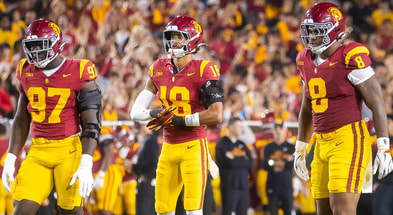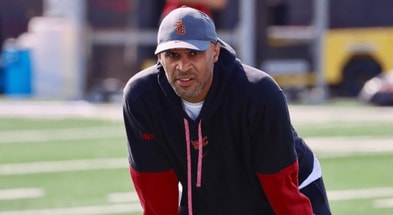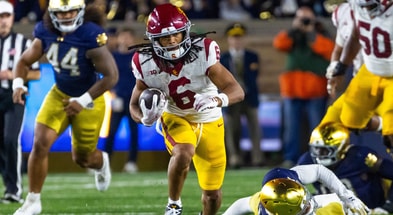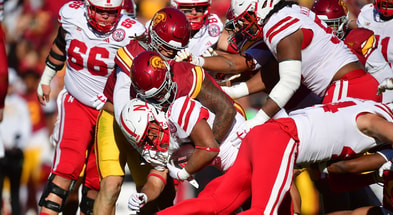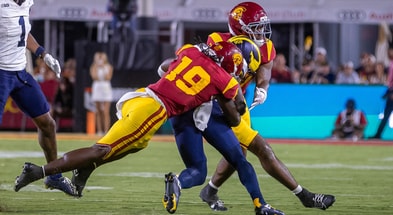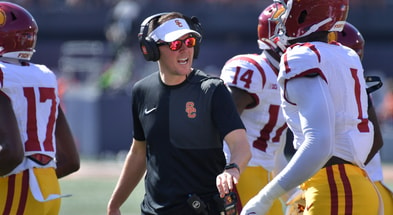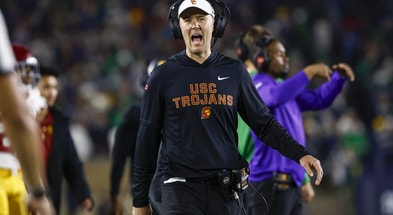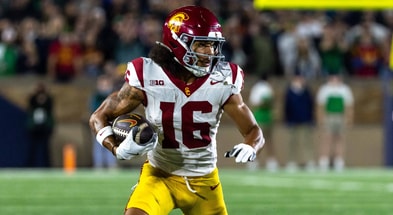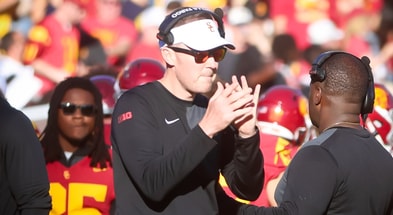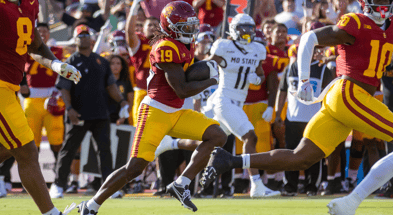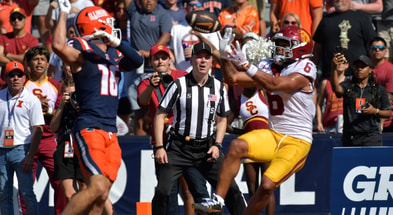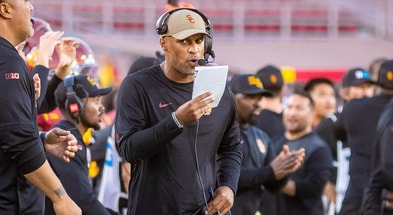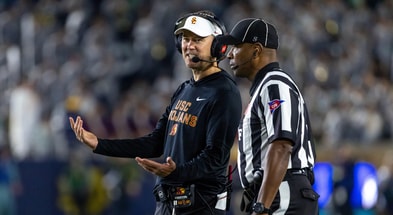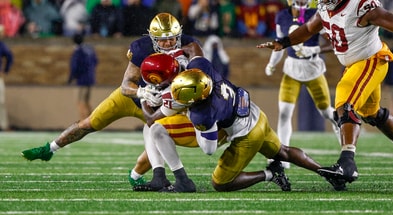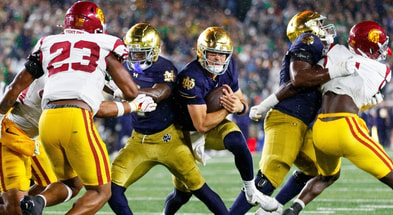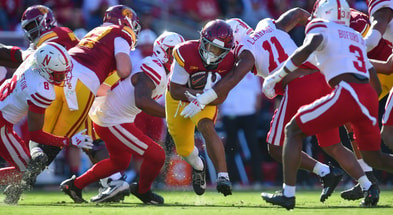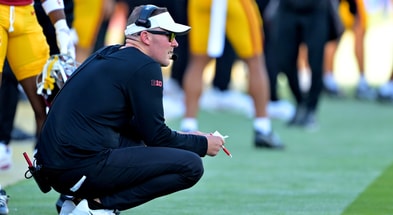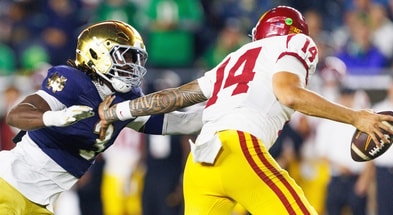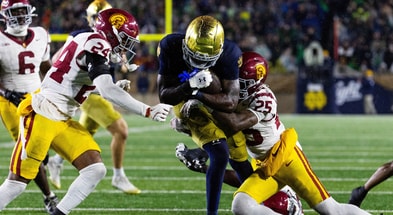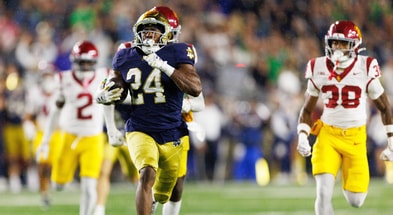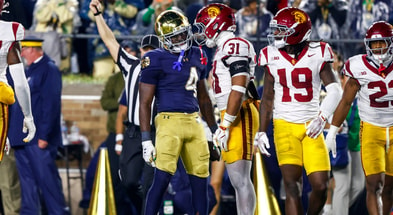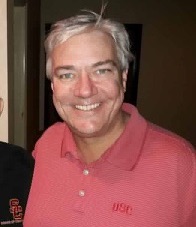Musings from Arledge: The new college football proposal

I’ve written many times in Musings about the chaotic and destructive state of college football. With the exception of Phil Knight and unlicensed player agents, I’m not sure anybody is excited about unlimited free agency, rampant tampering, and the hidden, and in many cases nefarious, way that money is promised, paid, and sometimes promised and then not paid.
Media reports say that representatives of the major conferences met secretly last week—clandestine meetings being the best way to deal with a situation caused by college-football powerbrokers who engaged in massive collusion for decades?—and they came up with an outline of a future plan.
The early idea seems to have a few key parts.
First, the NCAA will be split into multiple divisions, which can then operate by different rules. This is a no-brainer and is simply going to happen at some point, either within the NCAA framework or as part of a new governing body. It makes no sense for one body to set the same rules for wildly different sports—football and basketball, on the one hand, and field hockey or rowing, on the other hand—or different levels of play. There’s no reason Michigan and Alabama should play by the same rules as Appalachian State and San Jose State. This makes no more sense than having a governing body that oversees the NFL and local pickleball tournaments.
The new body would be able to set reasonable rules on things like the transfer portal, the NCAA seemingly having given up on everything other than continuing to collect March Madness money. Some transfer-portal reforms can involve player compensation—discussed below—but setting rules that allow for players to transfer at appropriate times rather than during the playoffs, for example, should be easy enough. And important enough.
Second, it seems clear that the universities want to end the Wild West that is the current NIL landscape. That is an important goal. But, remember, the reason NIL both exists and has gone insane is because the universities were so insistent that they keep all of the billions of dollars generated by college football, and—that not being nearly enough to appease the greedy amateurism gods—also stop athletes for making money on the side. We keep all the money that is generated directly from your play, and you don’t get to make any money from anybody else off your play. We win, you don’t win.
The federal courts—rightly—found these rules to be collusive and anti-competitive, and the NCAA was cut off at the knees.
The new proposal seems to involve regulation of NIL to ensure that NIL deals are true endorsement deals and not simply pay-for-play. NIL stands for “name, image, and likeness.” These terms are used to describe what a celebrity endorser is allowed to protect from unauthorized use and, therefore, sell to companies who might profit from the celebrity’s endorsement. But the current NIL landscape has little to do with such deals. Caleb Williams had real NIL value, and he signed real NIL deals. Arch Manning does. A handful of other college athletes have as well. But the bulk of NIL deals are simply pay-for-play deals—they’re salary for being on a team, and they are paid to players whose name, image, and likeness largely have no market value whatsoever. Quick, name the backup offensive left guard for the Texas Longhorns! You probably can’t because almost nobody can, but he’s almost certainly getting six-figure “NIL” money. That’s silly.
It’s also bad for a lot of people. The current situation provides far too much power to unaccountable alums and business moguls and creates too much room for unethical agents and constant tampering.
But the reason we’re here is because even today universities keep 100% of the massive revenues they generate from their football and, to a lesser extent, basketball programs. When you refuse to pay people what they’re worth, you allow a black market to fill that void.
So under the new proposal, a central body will assess whether NIL deals are legitimate endorsement deals or pay-for-play contracts. This should be easy enough to do. When college players who have never taken a snap and nobody has ever heard of have marketing deals as large as an NFL starting quarterback’s, it’s not hard to see the problem. And there are well-compensated professionals who make their livelihoods by estimating the value of a celebrity endorsement. It’s a well-developed market. This can be done and done fairly.
The question is whether the new rule will be enforceable. The NCAA and the universities have been clobbered in court recently for trying to limit player compensation.
The universities are trying to fix this problem by agreeing to a formula as part of the three class-action lawsuits against the NCAA that recently settled. The universities will agree on a formula that creates a pool of money from their sports revenues and will, in some undefined way, share that money with the players. In year one, those revenues will be slightly north of $20 million.
That’s a major step in the right direction. It’s still far below what professionals in all professional sports (other than the UFC) make. In almost every professional sport, the players make about 50% of the revenues. But $20 million is well below what every major college football program makes from football. So this is still a significant limit on player compensation, and therefore it still risks the wrath of the federal courts.
The NCAA and universities are trying to enforce the rules through the guise of the class-action settlements. And class-action settlements can be binding on members of the class who choose not to opt out. And there’s the rub. If players opt out of the class, the settlement terms are not binding on them. Enforcement of restrictions on their compensation will still, I suspect, be seen as collusive by the federal courts.
Top 10
- 1New
Jeremy Pruitt
Returns to college coaching
- 2Hot
Urban Meyer
Addresses return to coaching
- 3
October Superlatives
CFB's best, worst & more
- 4Trending
ESPN, YouTube TV dispute
Blackout begins now
- 5
Clark Lea
Vandy 'committed' to keep HC
Get the Daily On3 Newsletter in your inbox every morning
By clicking "Subscribe to Newsletter", I agree to On3's Privacy Notice, Terms, and use of my personal information described therein.
There are three ways around this problem. First, Congress can pass a law. If Congress passes a law that sets up the governing body and gives it authority to enforce NIL rules and determine appropriate compensation to players, the universities have their authority. Bills have been floating about Congress. So far, none has come close to becoming law. I need not share my view of the people in Washington to tell you that I’m still skeptical it will happen or, if it does happen, that the results will be reasonable.
Second, universities can make the players employees, allow them to unionize, and then cut a collective-bargaining agreement with them. That’s how the NBA and NFL owners enforce their rules without running afoul of the antitrust rules. (MLB doesn’t have to worry about it because they have a longstanding antitrust exemption.) But colleges are not excited about this, and for some very good reasons. Making athletes employees means a whole host of labor laws fall into your lap, and so do legal doctrines like respondeat superior, where the employer is responsible for various torts committed by employees. On top of that, the universities lose control. They are now dealing with a labor union which will push for far more than $20 million a year, and they may occasionally strike, like professional athletes do. And let’s be honest: other than governmental entities, there aren’t many employers in the world who want to deal with a union. The universities are going to fight this, even if the National Labor Relations Board (the NLRB) has started to make noise this direction. (Trump’s NLRB probably won’t go there, but Trump is unpredictable, and we’ll have a new administration in four years regardless.)
There is a third option that I think may offer another path forward. But it will require some changes to the plan the schools and NCAA are working up right now. Remember that the NCAA collapsed when courts found their rules collusive and without sufficient justification. But what if the NCAA abandoned any idea of a salary cap and let schools pay players directly—and they could pay them whatever they wanted and could afford, like almost every other business? But—and this is key—the moneys would have to come from legitimate football and basketball revenues, and that means television money, gate receipts, concessions, and merchandise sales of football or basketball items. Moneys donated cannot be used, and schools will have to pay their operating expenses with their legitimate revenues as well (to stop a mogul from donating a billion dollars to the university, which would allow them to use all of their legitimate revenues to pay players). Schools can still use donations for facilities and other big-ticket items.
This restriction is critical because it keeps donors and collectives out of the picture, and it effectively keeps unscrupulous agents or wanna-be agents out of the picture. Players could have licensed agents like professional players have, but that’s it. Yes, Ohio State could pay more to players than Purdue could, but that’s not so bad. No industry has a completely level playing field, and college football certainly hasn’t. For example, some programs are lucky and sit in Texas; others sit in Idaho. That’s going to impact your roster.
Essentially, you would have a Major League Baseball setup. True, the Dodgers and Yankees have far more money and can buy the best rosters. But other teams can still compete. The lack of a salary cap hasn’t completely ruined competitiveness.
Pushing for a salary cap is likely to run afoul of the antitrust laws, but telling schools they can only use their legitimate revenues to pay players but can pay them as much as they want? I think that works.
I think you can combine this with rules against fake NIL. The universities have all kinds of reasons to clamp down on fake NIL deals, including tampering and corruption. And, let’s face it, hidden NIL deals are likely to lead to tax problems for students and other difficulties. There are legitimate justifications for this rule, unlike the old “amateurism” rules. That’s why this rule could survive court scrutiny. The NCAA can have its rules against fake NIL, it can have its clearinghouse, and I think it would get a better reception from the courts.
There would be pushback in some areas. Some schools—Cough! Cough! Oregon! Cough!—probably prefer the existing rules. To steal from Hamilton, it must be nice, it must be nice, to have Uncle Phil on your side. But the bulk of universities don’t want the current system, and they’ll win the vote.
There are potential Title IX issues. Now, I try to stay out of politics in Musings, but in this case, I’m not intruding into politics, the politicians are intruding into football. So I’ll engage. In the final hours of the Biden administration, government bureaucrats claimed it would be a Title IX violation not to share moneys equally between male and female athletes. This is nonsense, and I use that term not to offend anybody. I use it because any other term I could use to describe this position would be even more offensive. The idea that the people who generate the money must share equally with athletes who not only don’t generate money but, literally, can only play because the profitable programs pay for their travel, uniforms, and everything else, is embarrassing. That’s not law, and it’s not reasonable. It’s politics, and it’s bad politics. I feel comfortable that the courts will ultimately agree with me.
This third option could be the way back to sanity. Jen Cohen, call me. Let’s make this happen.
